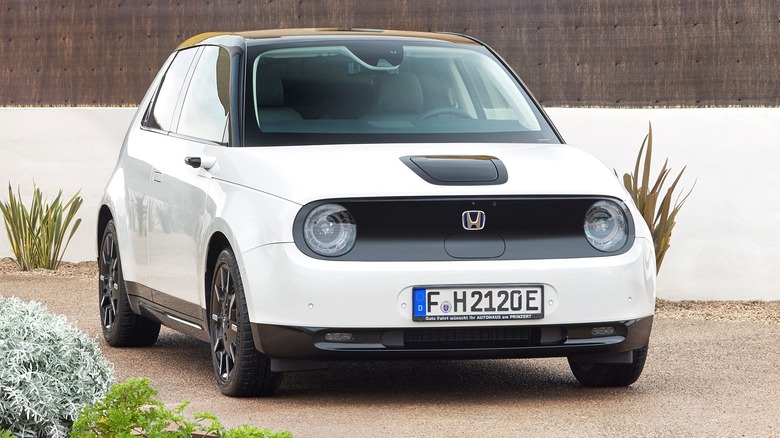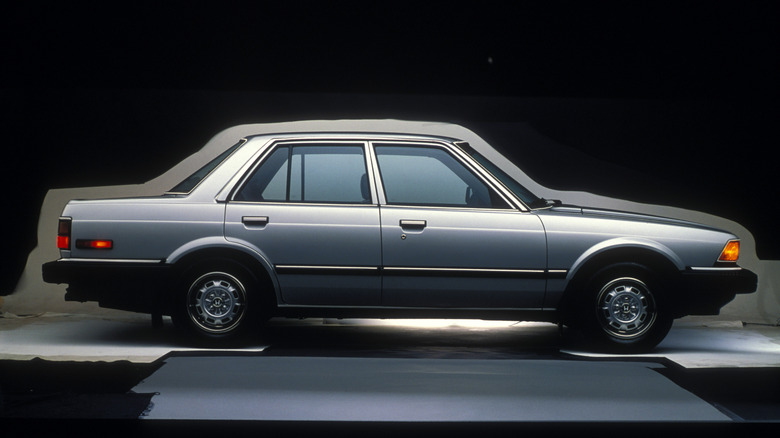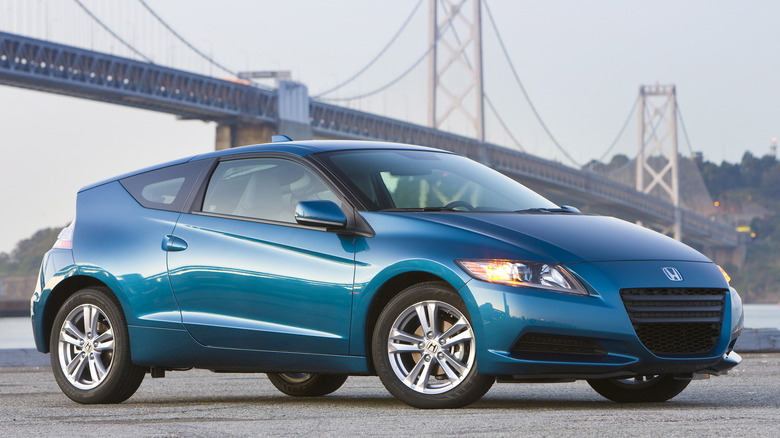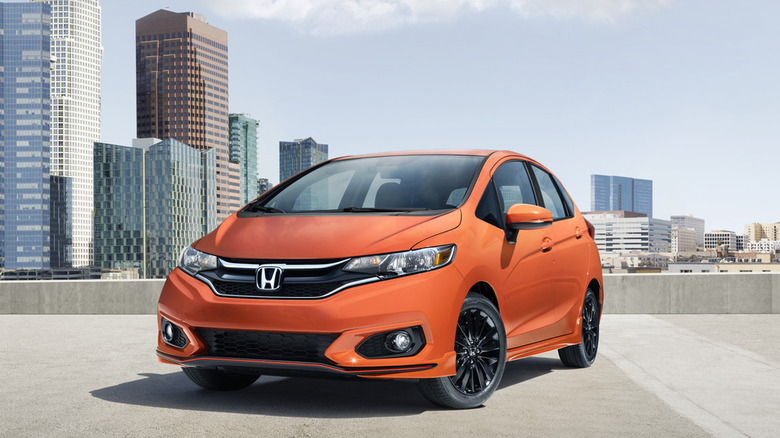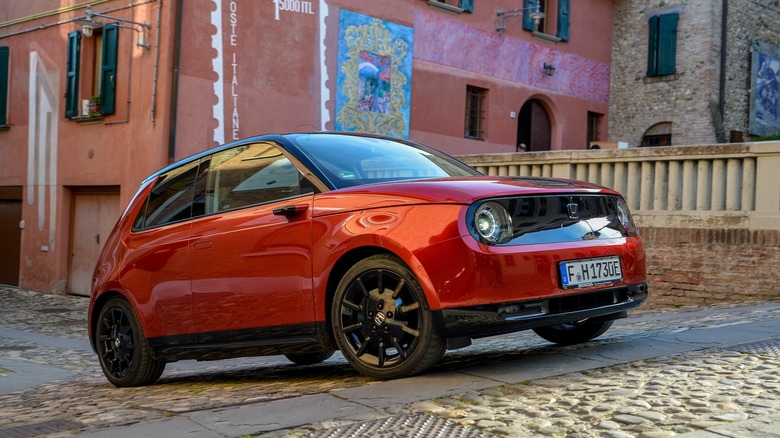Honda Needs To Make More Weird Little Cars
Today, Honda announced the Motocompacto, a goofy little electric scooter that can fold up and be stowed away with ease. It's a callback to the Honda Motocompo, a 50cc scooter that came bundled with the Japanese-market Honda City compact hatchback and could be stored in a special compartment in the trunk. It was a funny idea that quickly became an iconic part of Honda's history of making cars with mass appeal that were just a tad strange.
The Motocompacto continues that trend as, unlike other automakers that seemingly light money on fire as a normal course of business, Honda has the knowhow and infrastructure in place to actually deliver on its claims. Plus, it's worth noting that Honda knows more than a little bit about making scooters as well as affordable transportation that isn't dull. Although no one can accurately say that Honda's current lineup is "bad" (quite the opposite, in fact), all the same, it's sorely lacking in strange little cars that stick out in a sea of crossovers and huge EVs.
Honda's quirky past
The Honda City may have been a car for the Japanese market, but Honda's American offerings have had a bizarre streak too. The first Honda ever sold in the US, the 1970 N600 coupe was powered by a 600cc two-cylinder motorcycle engine. It's tiny compared to a Civic even from 20 years ago, and practically microscopic compared to any American cars from 1970 when the average engine size eclipsed six or even seven liters.
In the late 1970s and early 1980s, American automakers were slowly getting the message that not every car needed to be the weight and length of a Nimitz-class aircraft carrier, but Honda started with that assumption right off the bat. The first mass market Hondas to arrive in the United States, after the niche N600, were quirky and optimistic. Early Civics and Accords could have been bland, efficient boxes like the Chevy Chevette or Dodge Omni, but instead Honda gave the cars angular and dramatic outlines without sacrificing functionality or efficiency. Honda managed to do something that automakers at the time were too set in their ways to understand: It made a car that was genuinely fun to drive, very efficient, and didn't look like the automotive equivalent of a dentist's office.
By the time the late 1980s and 1990s rolled around, you couldn't walk 10 feet without seeing a new, wacky Honda. Cars like the Civic CRX were compact and downright strange compared to everything else on the road, yet produced by a major automaker and enjoyed mainstream success.
Recent weirdness
Even in more recent history, Honda was cranking out outlandish compacts. Now the Honda CR-V is a staple of grocery store parking lots and roughly the same size of every other mass market crossover today, but that was not always the case. The first CR-V from 1997 was a peculiar little SUV from a company that previously was only known for making sedans and motorcycles. Honda innovated in a place where it had never gone before, and very quickly became the standard for almost an entire segment of cars.
On the more unique end, Toyota's egg-shaped Prius may have won the popular vote when it came to successful early hybrids, but the Honda Insight was still the first hybrid from a major automaker stateside. The Prius has no doubt become one of the most important vehicles in modern history. Still, it speaks to Honda's latent ability to predict the future by beating the Prius to market, but also making a car like the Insight that still looks futuristic nearly a quarter-century after it was sold.
The Honda CR-Z, as short lived as it was, was a hybrid that looked like an outlandish concept car, yet it was still eminently practical as it could achieve a respectable 37 miles per gallon on the highway. It also was available with a six-speed manual. If any automaker today made a six-speed hybrid two-door hatchback today, the Internet would catch on fire. Honda did it over a decade ago.
The end of odd
The most recent weird little Honda was the Fit. Honda managed to bend the spacetime continuum with the Fit as it was capable of swallowing seemingly more cargo than a container ship, yet could squeeze itself into every parking spot on Earth. It was anything but an ordinary hatchback. It was significantly more stylish and intentionally designed than something like a Chevy Cruze from the era, and it was way more sporty than a similarly sized Nissan Versa Note. But alas, the Fit was axed in the United States in 2020.
The Honda Element was shaped like a shoebox, meanwhile, yet had tons of personality and charm. It had a fun design that worked in concert with its usability and practicality. Hondas today are usable and practical, but lack the intangible "fun" factor of cars like the Element.
With the Fit and Element's demise, Honda's lineup is completely vacant of diminutive little cars that have abundant personality. The Civic, Accord, and CR-V are all excellent cars that allow Honda to print money, and Acura's lineup and the existence of the Civic Type R prove that Honda is capable of having fun, but that same commitment to being different and quirkiness doesn't exist in the more pedestrian end of the range. If you want a fun and weird compact Honda, you're a few years late to the party.
EVs could be be Honda's playground
With the wave of EVs coming, Honda has a chance to make waves again like it did in the 1970s and 1980s. While General Motors refuses to make an EV that doesn't cost six-figures and weigh as much as a planet (aside from the Bolt, so of course that's being discontinued), and Ford has to turn to nostalgia to sell EVs (assuming it can even build them), Honda has more than ample room to swoop in and corner the market of real EVs for real people. It's already made the cool little hatchback that is the Honda e for markets other than the United States.
The market is begging for an EV that isn't huge and expensive, and Honda's lineup desperately needs something that's different and way weirder than commuter cars. Why not solve both of those deficiencies in the market with one Honda EV that proves not only that the automaker is capable of participating on the EV battlefield, but that it hasn't lost any of the creative genius that made the automaker so dominant in the first place. After all, you're going to need a car to complement your new Motocompacto.
